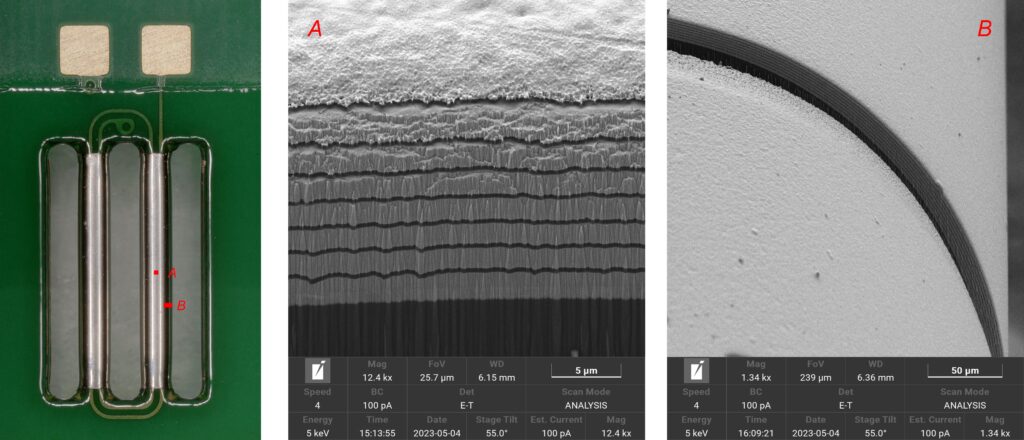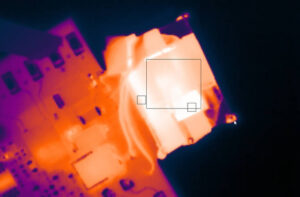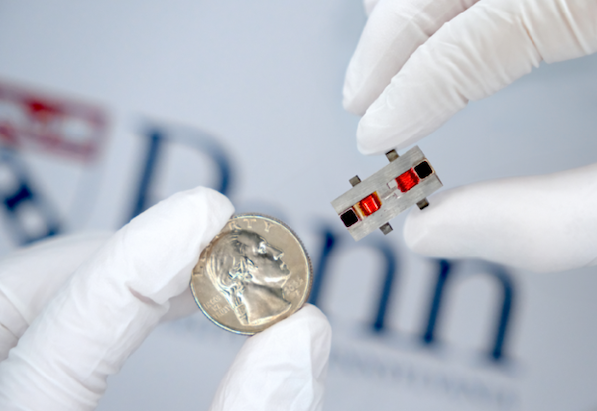The rapid development of small electronic devices puts forward high requirements for the components responsible for delivering power to these systems. Most power conversion circuits require magnetic components (inductors and transformers) to operate efficiently. However, these components have not been widely miniaturized. We are developing sequential, multi-layer electroplating as well as lithography and nano-lamination techniques to design the magnetic cores for small-scale transformers and inductors.

PCB inductors with the microfabricated laminated cores

Thermal image of a magnetic device under test
Contact at: Xuan Wang and Yixiao Ding
Rediscovering the lost art of magnetic circuit for 6G or Next G microwave fitlers.

Find more at:
- Frequency tunable magnetostatic wave filters with zero static power magnetic biasing circuitry, Nature Communications
- To 6G and Beyond: Penn Engineers Unlock the Next Generation of Wireless Communications, Penn Engineering Today
Contact at: Xuan Wang and Yixiao Ding
Nutrient runoff from agricultural lands leads to devastating environmental effects in downstream waterways, such as eutrophication. Limited information about soil nutrient levels could lead to overapplication of fertilizer to ensure good yield. We are developing biodegradable active soil monitoring units to enable real time access to high-spatial density information about soil nutrient levels without the complicated logistics of keeping track of and recollecting a large number of sensors. Key components in our current research efforts include a Zn-air battery and a phosphate sensor. Leveraging the inherent biodegradability of Zn-air chemistry and the abundant air as a limitless source, we have engineered batteries that enable seasonal power supply under sensor-relevant current loads, with the majority of components being biodegradable. Additionally, this ongoing development of biodegradable electronics, sensors, and power sources could be useful for environmental monitoring in inaccessible locations or reducing waste from abundant IoT devices and disposable sensors.
Publications:
- E. V. Schell, J. G. Murphy, J. R. Hawkings, A. F. Plante and M. G. Allen, “Degradable Mo-Based Phosphate Sensor for In-Soil Agricultural Monitoring,” 2023 IEEE SENSORS, November 2023.
- J. Zhang and M. G. Allen. “In-Soil Biodegradable Zn-Air Batteries,” Solid-State Sensors, Actuators, and Microsystems Workshop (Hilton Head 2022), June 2022.
Contact at: Elizabeth Schell
We are updating our website – stay tuned!
Fingertip Implantable MEMS Tactile Sensors
In the United States, there are more than five million people are paralyzed due to spinal cord injury, stroke and other causes. In recent years, there are studies on brain-machine interface technology where the patients can use their mind to control robotic arms or their own paralyzed hands so that restoring some daily activities like grasping would become possible for these patients. In order to fully restore the functionality, fingertip sensors for feedback are required to work with these actuators. We are developing a fingertip implantable tactile system for normal and shear force measurement with wireless power and signal transmission circuit encapsulated. The package is made of fused silica material so that it satisfies the hermeticity and biocompatibility requirements for long term implantation purpose. CO2 laser assisted simultaneous fusion bonding and dicing of fused silica wafers has been successfully demonstrated for encapsulation of CMOS circuits. Additional work to further evolve this packaging technology to a normal and shear force sensor is under investigation.
Publications:
- L. Du and M.G. Allen, “Silica Hermetic Packages Based on Laser Patterning and Localized Fusion Bonding,” 2018 IEEE 31st International Conference on Micro Electro Mechanical Systems (MEMS), Belfast, UK, Jan. 2018. (PDF)
- L. Du and M. G. Allen, “CMOS Compatible Hermetic Packages Based on Localized Fusion Bonding of Fused Silica,” Journal of Microelectromechanical Systems, vol. 28, no. 4, pp. 656-665, Aug. 2019. (PDF)L. Du, H. Hao, Y. Ding, A. Gabros, T. C. E. Mier, J. V. Spiegel, T. H. Lucas, F. Aflatouni, A. G. Richardson and M. G. Allen, “An implantable, wireless, battery-free system for tactile pressure sensing,” Microsystems & Nanoengineering, October 2023.(PDF)
- L. Du, H. Hao, Y. Ding, A. Gabros, T. C. E. Mier, J. V. Spiegel, T. H. Lucas, F. Aflatouni, A. G. Richardson and M. G. Allen, “An implantable, wireless, battery-free system for tactile pressure sensing,” Microsystems & Nanoengineering, October 2023.(PDF)
- Y. Ding, L. Du, H. Hao, T. C. E. Mier, J. V. Spiegel, T. H. Lucas, F. Aflatouni, A. G. Richardson and M. G. Allen, “A biocompatible glass-encapsulated triaxial force sensor for implantable tactile sensing applications,” 2024 IEEE MEMS, Januray 2024. (PDF)
Rechargeable, or secondary batteries, are required to power almost all of today’s increasingly complex technology. In most current commercial systems, high charge and discharge rates can lead to increased kinetic resistances and reduced energy density, while increasing size and active material mass can increase energy storage but reduce power. To bridge this application gap, MEMS techniques have been identified as promising methods to build high surface area battery electrodes that can be optimized to reduce these kinetic resistances while maintaining energy storage capability. To create batteries with potential to be manufactured on a large scale, these electrodes must be deterministically engineered and cost effective while providing this maximized performance. We are developing sequential, multi-layer electroplating as well as lithography and laser micromachining techniques to design these electrodes for use in a wide variety of applications. Additionally, new materials such as conductive and carbonized polymers are being investigated as both sacrificial and active layers to make the device fabrication more environmentally friendly and decrease costs, hopefully leading to enhanced commercial viability.